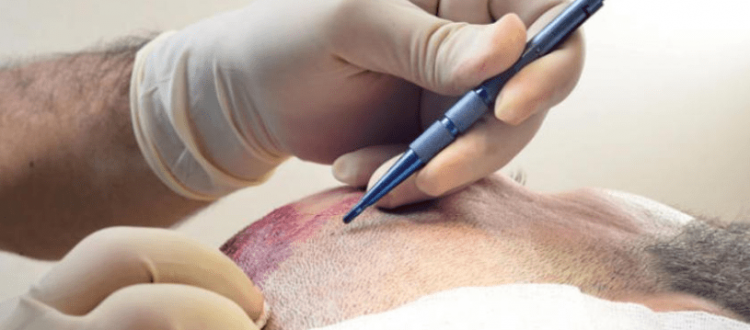- HOME
- ABOUT
- FACE SCULPTING
- SKIN
- BODY
- FACE
- EQUIPMENT
- POST PROCEDURE
- CONTACT US
- HOME
- ABOUT
- FACE SCULPTING
- SKIN
- BODY
- FACE
- EQUIPMENT
- POST PROCEDURE
- CONTACT US
HAIR TRANSPLANTATION: ADVANCED SURGICAL TECHNIQUES FOR BETTER RESULTS
admin
January 26, 2023

When hair falls completely, or massively, from areas of the scalp in men or women, hair transplantation can be a surgical procedure that changes a person’s life from an aesthetic point of view and gives him more self-confidence. This is because this type of surgery aims to regrow natural hair in areas of the scalp in which the presence of hair has thinned, or completely lost. With it, hair loss in eyelashes, eyebrows, and face can also be treated. It is also possible to restore hair in the areas that have been removed, due to scars from injuries and wounds, on the scalp, face, and others.
Major steps
Hair transplant is one of the elective therapeutic cosmetic procedures (Elective Surgery), which requires mastering the procedure of 3 steps by the person to whom this operation is performed, and 3 other steps by the surgeon who will perform it, in order to achieve the desired goal.
The three steps for the person who will have this operation include:
• Seeing an experienced specialist doctor, making sure of the person’s need for hair transplantation, as a solution to his baldness problem, and evaluating the suitability of his condition for that surgery.
• Understanding simplified aspects of the currently available techniques for conducting hair transplantation, the pros and cons of each, and the doctor’s discussion about the best treatment for his alopecia, and knowing the steps to perform this process and the shape of the hair growth distribution expected from it.
• Understand what is required of him before and after surgery, in relation to self-care, scalp skin, and hair. And know the expectations for the days and months after this operation.
As for the three steps for the surgeon who will perform this operation, they include:
• Mastering the patient preparation steps, pre-operative scalp preparation, and post-operative care steps.
• Mastering the steps of removing hair follicles, and keeping them in a state that accepts hair growth after transplantation.
• Mastering the steps to replant it in hairless areas of the scalp.
Baldness surgeries
It is worth noting that hair transplantation is one of the types of surgical procedures to deal with the problem of baldness. The American Society of Plastic Surgeons (ASPS) reports that there are several surgical techniques to deal with baldness on the scalp, and the most common of them is hair transplantation, but there are other surgeries. These surgeries can be done alone or in combination, including:
Flap Surgery: By moving the hair-bearing scalp tissues to the balding areas of the scalp.
Scalp Tissue Expansion Surgery: To expand the area of ?? the scalp skin carrying hair, and to help cover areas of the scalp that do not have hair, with the balloon technique.
Scalp Reduction Surgery: By removing the bald areas on the scalp, and bringing hair-bearing areas closer to the scalp.
ALSO READ: BIOFIBRE HAIR TRANSPLANT
Donor and recipient sites
Humans have approximately 5 million hair follicles distributed in the skin, of which only about 150,000 are scalp hairs. Natural hair grows in groups, each group containing between 1 to 4 hairs.
Accordingly, the hair transplantation process is carried out through two stages: The first is the removal of skin pieces containing hair follicles from a part of the body rich in strong healthy hair, often at the back of the scalp, and that area is medically called the “Donor Site”; The second step is the transfer of the skin pieces containing these hair follicles, and their transplantation in areas of low or no hair, which is medically called the “Recipient Site”.
Ensuring the success of hair transplantation depends on two things: First, in the “donor site”, the completion of hair removal that preserves the life of the hair follicle in it; And the other, in the “receiving site”, is the completion of the implantation of hair follicle units within the skin in a way that allows them to integrate biologically into the surrounding tissues, so that they become a natural part of it.
Extraction and eradication
There are two main methods of Extraction and eradication
Foss method: The first method is called “Strip Harvesting”, also called (Follicular Unit Strip Surgery), or the “FUSS” method.
The Voss method is the previously dominant method, in which the surgeon under local anesthesia cuts a strip of skin 15 to 25 centimeters in length and between one and a centimeter and a half in width from the skin at the back of the scalp.
The Foy method: It is the second method called “Follicular Unit Extraction”, short for “FUE”.
The Foy surgeon, under local anesthesia, performs an individual procedure of extracting the hair follicle unit, that is, it contains between one to 4 hairs, in the form of small skin pieces ranging from 0.6 (zero points six) a millimeter to 1 millimeter.
This process may be completed in one treatment session, or during several sessions, because it takes longer than the “tape extraction” method of hair transplantation.
After the operation, either of the two methods, the scalp may be sore, and the patient may need to take medications after hair transplant surgery, such as pain medication, antibiotics to reduce the risk of microbial infections, and taking anti-inflammatory drugs that reduce the chances of swelling of the surgical areas. The area of ?? transplantation may also be treated with laser, or the patient is advised to use topical medicinal preparations to stimulate hair growth.
It is normal for the transplanted hair to fall out after 2 to 3 weeks of the operation, in order to give an opportunity for new hair to grow. The final results of the operation are evident with new hair growth after a period of 8 to 12 months.
Who does it suit? What are its possible complications?
The American Society of Plastic Surgeons reports that a person may be a good fit for hair transplant surgery if he has healthy hair growth at the back of the head, and adds: “Hair transplant surgery can enhance your appearance and confidence in yourself, but the results will not necessarily match the ideal expectations.
As with any surgery, the infection may occur, and bleeding or extensive scars may occur. There is a possibility that some transplanted skin pieces will not join together, and that hair will fall out in those spots.
Scientific comparisons between different technologies
The two main methods of surgically transplanting hair are “Strip Harvesting”, or “Foss” method, and “Follicular Unit Extraction”, or “Foy” method. . In comparison, the following can be noted:
The formation of the surgical scar. In the “Voss” method, a light line of surgical scar (Linear Scar) is inevitably produced in the area of ?? removal of the strip of skin, and it may be obviously thick in a few cases, and also evident for those who desire short hair. There are several surgical precautions in the method of closing the wound, relieving skin tension in it, and preserving the hair follicles around it, to reduce the size of the scar and ensure the growth of hair around it. On the other hand, the most important advantage, and even the main reason behind the development of the FOI technique, is to avoid the formation of a clear surgical scar.
Ensure the survival of the transplanted hair. In the “Foy” method, there are higher chances of the hair growth and the continuity of its life (Graft Survival), because the small pieces of skin containing the hair unit contain little tissue surrounding the hair follicles (Perifollicular Tissue), which contributes to the high probability of continuity of their life. Its small size also makes it more prone to graft drying, and the ease of exposure to damage by tissue pressure around it, which are two of the important reasons for hair transplant failure. Therefore, the surgeon’s experience and precision in mastering the hair transplant procedure makes its results excellent.
On the other hand, with the Voss method, the chances of ensuring that the transplanted hair remains shiny, increase
Recent Posts
Have Any Question?
- +92-347-0008397
- [email protected]

